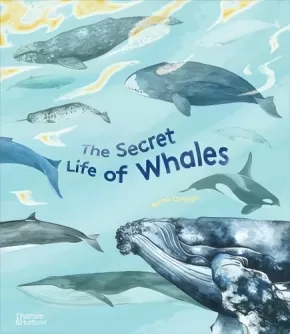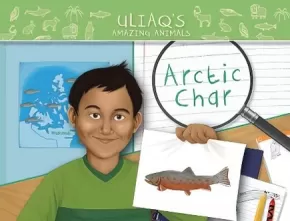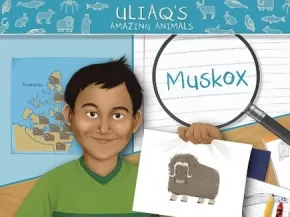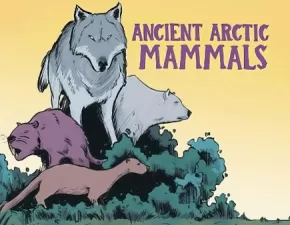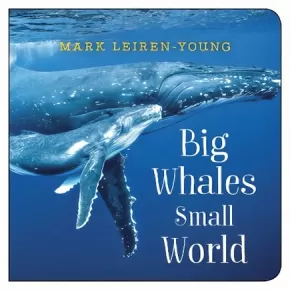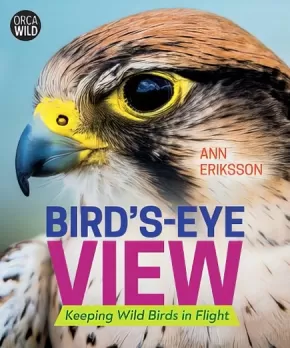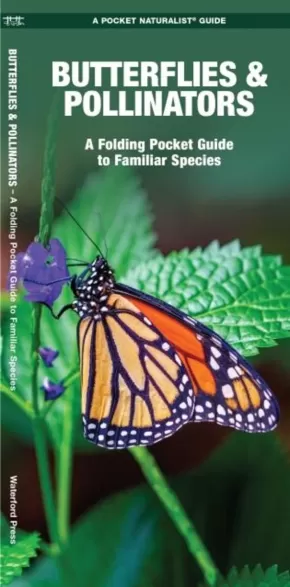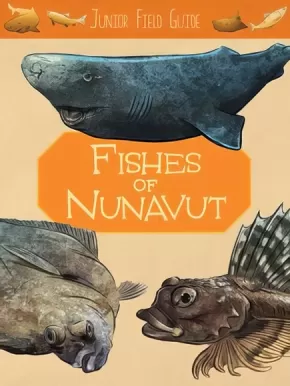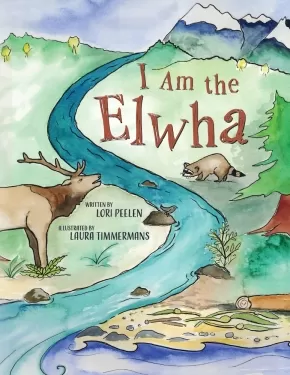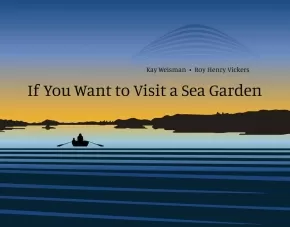
Plants and Animals
121
-
135
of
371 Results;
Sort By
Go To
of 25
The Secret Life of Whales
$22.95
Artists:
Format:
Hardcover
ISBN / Barcode: 9780500652671
Synopsis:
Synopsis:
Meet some of the ocean’s most incredible creatures in this beautifully illustrated and expansive exploration of whales.
Whales are amazing and ginormous mammals—they are some of the biggest creatures to have ever lived on Earth! This beautifully drawn children’s nonfiction book shares some of the most incredible and thrilling truths about the many different kinds of whales. From where they migrate to how they care for their young, The Secret Life of Whales is full of fascinating facts. With so many things to learn, young nature lovers won’t be able to put down this charmingly illustrated introduction to these elusive animals.
Educator Information
Recommended for ages 6 to 8.
Additional Information
48 pages | 11.00" x 12.50"
The Wolf Mother
$23.00
Artists:
Format:
Paperback
Text Content Territories:
Indigenous Canadian; First Nations; Gitxsan (Gitksan);
ISBN / Barcode: 9781553799788
Synopsis:
Synopsis:
Follow along as award-winning author Hetxw’ms Gyetxw (Brett D. Huson) introduces young readers to a pack of gray wolves. New pups have just begun to open their eyes, one of which is a striking black female. Every day, her ears grow larger, her eyesight gets sharper, and her legs stretch farther. As she learns to hunt, play, and run with her pack, instinct pulls her to explore beyond her home territory. Will the young wolf’s bold spirit help her find a new pack of her very own?
Learn about the life cycle of these magnificent canines, the traditions of the Gitxsan, and how gray wolves contribute to the health of their entire ecosystem.
Educator & Series Information
Recommended ages: 9 to 11
This is the fifth book in the Mothers of Xsan series, which uses striking illustration and lyrical language to bring the poetry of the Xsan ecosystem to life. The traditional Gitxsan formline art and language weave together throughout the stories in this series to paint a vivid picture of the Gitxsan people.
Mothers of Xsan is a collection of stories that connects the world to the matrilineal society of the Gitxsan people, located in the Pacific Northwest Interior of British Columbia. Each book in the Mothers of Xsan series showcases the depth and importance of the knowledge that has been gathered and shared through this unique style of storytelling. The stories of life cycles, connection to the land, and language are told from the perspective of the animals from the Gitxsan’s traditional territory.
The series presents scientific knowledge in language and a format that is accessible.
Additional Information
32 pages | 6.50" x 10.00" | Paperback
Uliaq’s Amazing Animals: Arctic Char - Nunavummi Reading Series
$8.95
Format:
Paperback
Text Content Territories:
Indigenous Canadian; Inuit;
ISBN / Barcode: 9781774503652
Synopsis:
Synopsis:
Uliaq loves animals! One of his favourite animals is the arctic char. In this book, Uliaq gives facts about arctic char, where they live, what they eat, and why they are amazing!
Educator & Series Information
This book is part of the Nunavummi Reading Series, a Nunavut-developed series that supports literacy learning while teaching readers about the people, traditions, and environment of the Canadian Arctic. It is a Level 9 book in the series.
Nunavummi Reading Series books have also been officially levelled using the Fountas & Pinnell Text Level Gradient™ Levelling System. This book's F&P Level is K.
Curriculum Connections: Readers learn about the natural environment of the Arctic in this book and focus specifically on a fish found in the Arctic, the arctic char.
Recommended ages: 6 to 8.
Additional Information
24 pages | 6.00" x 8.00" | colour photographs
Uliaq’s Amazing Animals: Muskox - Nunavummi Reading Series
$8.95
Artists:
Format:
Paperback
Text Content Territories:
Indigenous Canadian; Inuit;
ISBN / Barcode: 9781774504628
Synopsis:
Synopsis:
Uliaq loves animals! One of his favourite animals is the muskox. In this book, Uliaq gives facts about muskox, where they live, what they eat, and why they are amazing!
Educator & Series Information
This book is part of the Nunavummi Reading Series, a Nunavut-developed series that supports literacy learning while teaching readers about the people, traditions, and environment of the Canadian Arctic. It is a Level 9 book in the series.
Nunavummi Reading Series books have also been officially levelled using the Fountas & Pinnell Text Level Gradient™ Levelling System. This book's F&P Level is K.
Curriculum Connections: Environmental awareness, life systems, Arctic animals
Recommended ages: 6 to 8.
Additional Information
24 pages | 6.00" x 8.00" | Paperback
A Field Guide to Crabs of the Pacific Northwest
$7.95
Format:
Pamphlet
Reading Level: N/A
ISBN / Barcode: 9781550179095
Synopsis:
Synopsis:
Crabs can be found in abundance along the shorelines from Oregon to BC, burrowed under sand, soil and rocks. Keep this portable field guide handy on trips to the seashore to identify over forty species of crabs and hermit crabs in all shapes and sizes. Discover the differences between the Butterfly Crab and the Puget Sound King Crab and learn how to distinguish between male and female crabs. With full-colour photographs featuring both dorsal and ventral views, and accompanied by descriptive text for easy identification, A Field Guide to Crabs of the Pacific Northwest is an ideal companion for curious beachgoers of all ages.
Additional Information
2 pages | 37.00" x 9.00"
A Field Guide to Fossils
$7.95
Artists:
Format:
Pamphlet
Reading Level: N/A
ISBN / Barcode: 9781550179101
Synopsis:
Synopsis:
From dinosaur bones to petrified wood and from primordial seashells to archaic oddballs, this handy field guide makes identification of fossils a cinch. Learn how to identify a fossil and discover the most up-to-date tips on where and when to hunt for them. Featuring gorgeous full-coloured photos and paired with short and informative descriptions, this field guide is suitable for fossil enthusiasts of all ages and skill levels. Lightweight and pocket-sized for convenience, A Field Guide to Fossils is easy to grab and toss into any fossil lover’s backpack on their next adventure.
Additional Information
2 pages | 37.00" x 9.00" | 65 colour photographs | Pamphlet
A Walk on the Shoreline
$12.95
Artists:
● Qin Leng
Format:
Paperback
Text Content Territories:
Indigenous Canadian; Inuit;
ISBN / Barcode: 9781772272697
Synopsis:
Synopsis:
Like A Walk on the Tundra, A Walk on the Shoreline introduces young readers to unique plants and animals found in the Arctic, as well as the traditional Inuit uses for the various species.
Young Nukappia can’t wait to get out to his family campsite on the shoreline. After spending all year in the south with his adoptive parents, Nukappia always looks forward to his summer visits with his birth family. After spending one night in town, Nukappia and his uncle Angu begin the long walk down the shore to the family summer campsite, where all of Nukappia’s cousins and aunts and uncles are waiting for him. Along the way, Nukappia learns that the shoreline is not just ice and rocks and water. There is an entire ecosystem of plants and animals that call the shoreline home. From seaweed to clams to char to shore grasses, there is far more to see along the shoreline than Nukappia ever imagined.
Reviews
“A Walk on the Shoreline also has a full-colour glossary of the plants and animals that Nukappia encounters along the way, including photographs, quick facts and traditional uses of the plant or animal. A Walk on the Shoreline is a well-researched, informative and engaging guide to the northern shoreline. The information is well-placed and woven through the text in an engaging manner. The reader gets to learn along with the protagonist, focusing more on the flora and fauna along the way than the rest of the northern setting. This focus on one detail of living in Nunavut works well; it doesn’t try and add too many details, but it provides a thread along the way.” — CM Magazine
“This reunion story features detailed character and scene-setting sketches by Qin Leng that help readers see how traditional Inuit communities live.” — Hakai Magazine
Educator Information
Recommended Ages: 5-7.
Additional Information
40 pages | 8.50" x 8.50"
Ancient Arctic Mammals - Nunavummi Reading Series
$12.95
Artists:
Format:
Paperback
ISBN / Barcode: 9781774500743
Synopsis:
Synopsis:
Learn about some of the mammals that roamed the Arctic long ago! From seals that walked on land to giant bears, this book features different mammals that once lived in the Arctic.
Educator & Series Information
This book is part of the Nunavummi Reading Series, a Nunavut-developed series that supports literacy learning while teaching readers about the people, traditions, and environment of the Canadian Arctic. It is a Level 13 book in the series.
Nunavummi Reading Series books have also been officially levelled using the Fountas & Pinnell Text Level Gradient™ Levelling System. This book's F&P Level is O.
Recommended for ages 7 to 9.
Additional Information
36 pages | 9.00" x 7.00" | Paperback
Big Whales, Small World (BB)
$10.95
Format:
Board Book
Grade Levels: Preschool;
ISBN / Barcode: 9781459825024
Synopsis:
Synopsis:
Take a dive in the oceans of the world with whales big and small!
In Big Whales, Small World you will meet whales from around the world. This rhyming photographic board book visits the oceans of places like New Zealand, Russia and South America. Writer, filmmaker and orca activist Mark Leiren-Young introduces young readers to blue whales bigger than dinosaurs and tiny vaquitas who swim close to shores.
Educator Information
Board book for ages 0-2.
Young readers learn one interesting fact about each marine mammal in this clever, rhyming board boook.
It is illegal to take underwater pictures of certain endangered whales. All of the photos in this book were sourced and taken legally.
Keywords / Subjects: whales of the world, ocean, environment, sea mammals, orcas, endangered animals, marine life.
Additional Information
24 pages | 7.00" x 7.00"
Bird's-Eye View: Keeping Wild Birds in Flight
$24.95
Format:
Hardcover
ISBN / Barcode: 9781459821538
Synopsis:
Synopsis:
Let's flock together to save wild birds.
Wild birds are everywhere, from the dry deserts to the icy poles. We see them soaring overhead, paddling across water, flitting through trees, pecking at the ground or our backyard bird feeders and singing from fence posts. Birds contribute to the health of the planet and provide pleasure for millions of people, but wild birds are in trouble. Today, almost 200 bird species are critically endangered. They are threatened by habitat loss, invasive species, climate change, pesticides, plastics in the environment, human-made structures and other animals. Bird’s Eye View looks at why wild birds are important, why they need help and what young people all over the world are doing and can do to give wild birds a boost.
Educator & Series Information
Recommended for ages 9 to 12.
Key Features:
- Wild birds are in trouble around the world. In this book, kids learn what they are can do, in their own backyards, to help convserve them.
- There is a widespread and thriving birding community of people all over the world who are invested in the future of birds, from scientists, to birders, to backyard enthusiasts and the general public. The book features approximately ten profiles of young birders and what they’re doing, around the world, to protect birds and their habitats.
- The author is a biologist, conservationist and passionate about birds and other wildlife. She’s a director of the Thetis Island Nature Conservancy and the Cowichan Community Land Trust.
This book is part of the Orca Wild series that examines the intricacies of animals, ecosystems, humans and our relationships to each other.
Keywords / Topics: bird conservation, ornithology, endangered species, habitat loss, young birders
Additional Information
144 pages | 7.50" x 9.00"
Butterflies & Pollinators: A Folding Pocket Guide to Familiar Species
$11.95
Format:
Pamphlet
Reading Level: N/A
ISBN / Barcode: 9781620054666
Synopsis:
Synopsis:
Some of the most vibrant colors and patterns in the Animal Kingdom are found among butterflies. Gawdy swallowtails, exquisite gossamer-wings, and a multitude of eye-catching brushfoots are particular standouts, though plenty of whites, sulphurs, metalmarks, and skippers are also adorned with splendid markings. Flowering plants across North America attract some 700 butterfly species as well as thousands of moths, bees, wasps, flies, and beetles, not to mention some hummingbirds and bats. This portable reference is a handy tool for those wishing to deepen their understanding of butterflies and other colorful pollinators. It features beautiful illustrations of 70 familiar butterflies and moths as well as some especially common larvae and pupae. Also included are notes on life cycles and other common pollinators. Laminated for durability, this lightweight, 12-panel folding pocket guide is a terrific resource for educators, learners, naturalists, and gardeners.
Additional Information
12 pages | 4.10" x 8.35"
Fishes of Nunavut (9 in Stock)
$12.95
Artists:
Format:
Paperback
Text Content Territories:
Indigenous Canadian; Inuit;
ISBN / Barcode: 9781774500521
Synopsis:
Synopsis:
There are lots of fishes in the Arctic!
Learn about the different types of fishes that live in Nunavut waters. This non-fiction science book provides information about what different types of fishes look like, where they live, what they eat, and other interesting facts about them, along with colourful illustrations and photographs.
Educator & Series Information
Recommended for ages 8 to 10.
This book is part of the Junior Field Guide series. Perfect for learning all about living things in the Arctic! These Junior Field Guides give information and interesting facts about the different animals that live in Nunavut.
Includes some traditional knowledge about the animals included.
Curriculum Connections: Supports science units on the natural environment and animals of the arctic.
Simpler, classroom-ready version of the adult book Common Fishes of Nunavut. Includes one spread per species, with information like where they live, what they eat, what they look like, and other facts. Includes a glossary of English biological terms at the back.
Additional Information
32 pages | 7.50" x 10.00" | Paperback
I Am the Elwha (HC)
 $18.50
$18.50

Artists:
Format:
Hardcover
Text Content Territories:
Indigenous American; Native American; Salish; Coast Salish; Klallam (Clallam); Lower Elwha Klallam Tribe;
ISBN / Barcode: 9781771744744
Synopsis:
Synopsis:
“I am the Elwha, rushing down to the sea. I am the Elwha, wild and free.”
The Elwha River flows 72 kilometres (45 miles) from its source in the Olympic Mountains to the Strait of Juan de Fuca in the Pacific Northwest. Uniquely, it hosts all six salmon species (Pink, Chinook, Coho, Sockeye, Steelhead, and Chum) as well as several species of trout.
In 1911 two dams were built on the river. The dams blocked the migration routes of the salmon and dramatically altered the entire river ecosystem for 100 years. In 2012 the dams were decommissioned and the world’s largest dam removal and habitat restoration project began.
In this lyrical and beautifully illustrated book, the author chronicles the history of the Elwha. Narrated by the powerful voices of plants and animals that inhabit the river ecosystem, the dam builder, a worker, and the river itself, this story celebrates the ongoing rewilding of this special environment and offers a welcome to all of the creatures who are coming home.
To learn more visit: www.elwha.org
Awards
- 2021 Riverby Award for Young Readers
Reviews
“I Am the Elwha is a powerful read about a powerful river and those who value and protect it." – Raina Delisle, Hakai Magazine
Educator Information
At the back of the book are three pages of cultural, scientific, and historical information that discuss the following:
- the importance and symbolism of salmon to the Lower Elwha Klallam Tribe and other Coastal Salish Tribes
- facts about the six species of salmon found in the Elwha River (Chinook, Pink, Chum, Sockeye, Coho, and Steelhead)
- the history of the Elwha River and its status today
Keywords / Subjects: The Elwha River, Rivers, Dams, History, Environmental Awareness, Lower Elwha Klallam Tribe, Coast Salish, Native American, Culture, Washington, Animals, Salmon, First Salmon Ceremony, Plants, Nature, Settlers, Social Responsibility, Environmental Activism, Poetry.
Recommended for grades 3 to 7.
Additional Information
32 Pages | 8.5" x 11" | ISBN: 9781771744744 | Hardcover
Authenticity Note: This lyrical story, which chronicles the history of the Elwha River, is written by Lori Peelen. Robert Elofson, Tribal Elder and Harvest Manager in the Natural Resources Department for the Lower Elwha Klallam Tribes, approved Lori's work and contributed a few pages of back matter at the end of the work. Lori's story was further approved by Frances Charles, the Tribal Councilwoman for the Lower Elwha Klallam Tribe, after the entire council read and approved it.
The Canadian Content label has been applied because the illustrator of this work is Canadian.
If a Tree Falls: The Global Impact of Deforestation
$19.95
Format:
Hardcover
ISBN / Barcode: 9781459823556
Synopsis:
Synopsis:
Every day more of the world’s forests disappear. Trees are cleared for agriculture, lost in wildfires and harvested for the valuable products they supply. Called the lungs of the planet, forests play a critical role in climate moderation. What happens when they’re gone? Are replanting and afforestation efforts helping?
In If A Tree Falls: The Global Impact of Deforestation, author Nikki Tate gives an accessible and balanced look at forest practices throughout history, the growth of industry and the fight for preservation. Global deforestation affects us all. Find out what you can do to protect forests today and keep them healthy for future generations.
Reviews
“Impressively detailed, this is a valuable addition to the nonfiction shelf.” — Kirkus Reviews
“Add this informative book on a topic of urgent concern to your collection. Highly Recommended.” — CM: Canadian Review of Materials
“Reader-friendly and informative…An enlightening purchase for all nonfiction collections.” — School Library Journal
Educator & Series Information
This book is part of the Orca Footprint series. Kids today inhabit a world full of complex—and often mystifying—environmental issues. Orca Footprints aim to help kids answer their questions about the state of the natural world with well-researched, simply-expressed information and powerful images. With topics such as food production, water, cycling and sustainable energy, these books will inspire kids to take action.
Recommended for ages 9-12.
Additional Information
48 pages | 8.00" x 9.50" | Hardcover | Colour Illustrations and Photographs
If You Want to Visit a Sea Garden
$18.99
Format:
Hardcover
Text Content Territories:
Indigenous Canadian;
ISBN / Barcode: 9781554989706
Synopsis:
Synopsis:
Discover the wonder of ancient sea gardens on the Northwest Coast
Sea gardens have been created by First Peoples on the Northwest coast for more than three thousand years. These gardens consist of stone reefs that are constructed at the lowest tide line, encouraging the growth of clams and other marine life on the gently sloped beach.
This lyrical story follows a young child and an older family member who set out to visit a sea garden early one morning, as the lowest tides often occur at dawn. After anchoring their boat, they explore the beach, discover the many sea creatures that live there, hear the sputtering of clams and look closely at the reef. They reflect on the people who built the wall long ago, as well as those who have maintained it over the years. After digging for clams, they tidy up the beach, then return home.
An author’s note provides further information about sea gardens (also known as clam gardens), which yield a reliable food source and have been traditional places of learning. They have been found along the Pacific coast, from Alaska to British Columbia to Washington State, and some of these gardens are being restored today.
The manuscript has been vetted and approved by the scientists of the Clam Garden Network and Kwaxsistalla Wathl’thla Clan Chief Adam Dick. Roy Henry Vickers, whose ancestry includes the Tsimshian, Haida and Heiltsuk First Nations, has created hauntingly beautiful images to accompany the text.
Reviews
“The text and illustrations combine grace and knowledge, offering a stunning nonfiction picture book that celebrates First Nations cultural traditions.” — School Library Journal
“This engaging tale is a natural for lessons about ecology and units on Indigenous peoples, and the illustrations will pop for story-hour audiences.” — Booklist
Educator Information
Recommended for ages 5 to 8.
Recommended in the Indigenous Books for Schools 2020/2021 resource list as being useful for grades K to 3 for Science and Social Studies.
Additional Information
32 pages | 10.25" x 8.50"
Sort By
Go To
of 25

